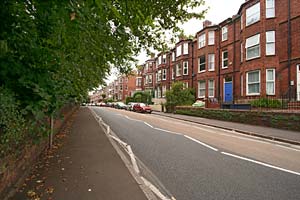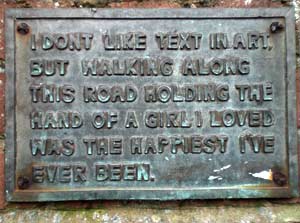
Blackall Road
Page updated 20 June 2009
The first, embryonic attempt at a road on the line of the Blackall Road, next to the London and South Western Railway, was in February 1858 when the Street Committee considered a request for a 6ft footpath to be cut between Barrack Road and Hillscourt. Then, in February 1874, a request was considered to cut a road from the County Constabulary, at the prison to Barrack Road, alongside the railway line. In the event, Blackall Road was laid out as a private road, and in 1876, the City Council resolved to name the road Blackall Road.
In 1877, the City Council widened the road at the Hillscourt end, and the first housing in the new road was completed. The Council proposed to widen and improve the road at a cost of £1,250 in 1882, and started to negotiate with two landowners. Mr Blackall declined to sell if the terms varied from an offer at the previous Streets Committee meeting.
Mr S Jerred, who had been to court in 1873, regarding the ownership of some land and the Retreat public house in Howell Road, offered to sell to the Council, in January 1883, the land at a cost of 6d per foot, which the Council accepted, as they thought the improvement to Blackall Road would result in the value of the balance of the land increasing. Then in April of the same year, he changed his offer to sell two acres of land, the public-house and dwelling house for £4,500, which quite "took the breath away" from the committee. If that wasn't acceptable, they could purchase the land, less the buildings for 1s per foot. Quite what the outcome of these negotiations were, is not clear, but it would seem that the Council did eventually improve Blackall Road.
Noisy neighbours
By 1897, the rest of the housing was built. However, all was not well for the inhabitants of Blackall Road, for in January 1899 they signed a memorial (petition) which was sent to the Town Clerk regarding the "Electric Light Works, increasing noise, vibration, and smoke in connection with the works, which had become a great nuisance, and a serious deterioration of their property." The works had been in existence since 1889, so one feels there was a touch of NIMBYism in the complaint. By 1905, the nuisance had gone away when the new Electricity Generating Station opened at Haven Banks and the New North Road works were closed.
During the Second War, No 6 and 7 Blackall Road were listed as a total loss after the May 1942 blitz, although there were no casualties recorded.
Bishop Blackall Girls' School was built in 1888, on land that belonged to the Episcopal Schools Trust. Opened as the Middle Class School for Girls, it became the Episcopal Modern School and finally, in 1934, Bishop Blackall School before closing. It is now an annexe of Exeter College.
There
was one casualty from Blackall Road during World War One.
Trimmer, Robert Rendall Flint, S.S. "Jose
de Larrinaga" (Liverpool), Mercantile Marine. 28 April 1917. Age 34.
An unnamed poet, placed a plaque in the wall between Blackall Road and the railway:
"I don’t like text in art
but
walking along this road
holding the hand of a girl I loved
was
the happiest I’ve ever been"
A plaintiff call from someone in love.
Sources: The Flying Post and Exeter Burning by Peter Thomas. With thanks to Laura Broom for knowing the text of the poem.
 Blackall
Road.
Blackall
Road.
 Bishop
Blackall School is at one end of Blackall Road - strangely it is not
named after the road.
Bishop
Blackall School is at one end of Blackall Road - strangely it is not
named after the road.
 The plaque from the unnamed poet. Photo by Laura Broom.
The plaque from the unnamed poet. Photo by Laura Broom.
│ Top of Page │